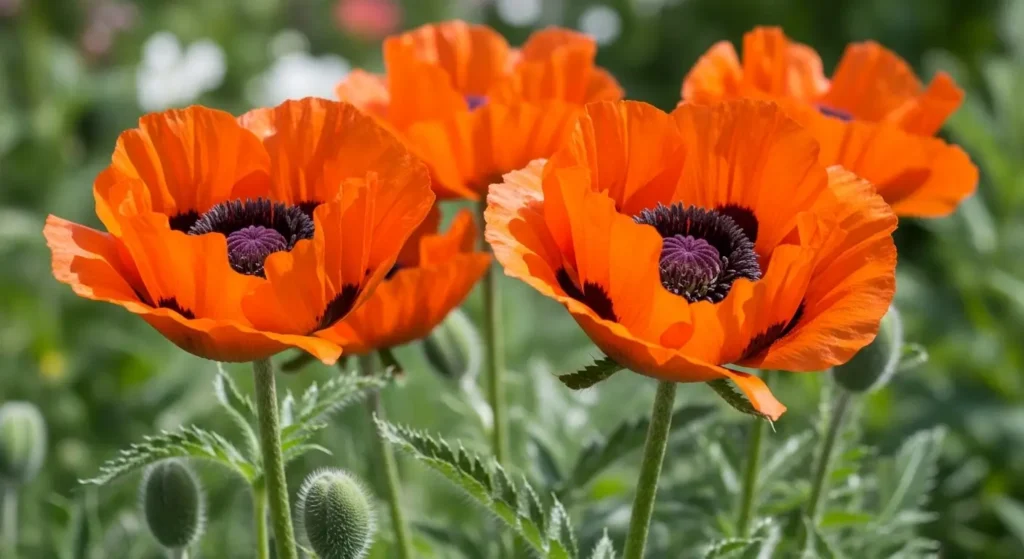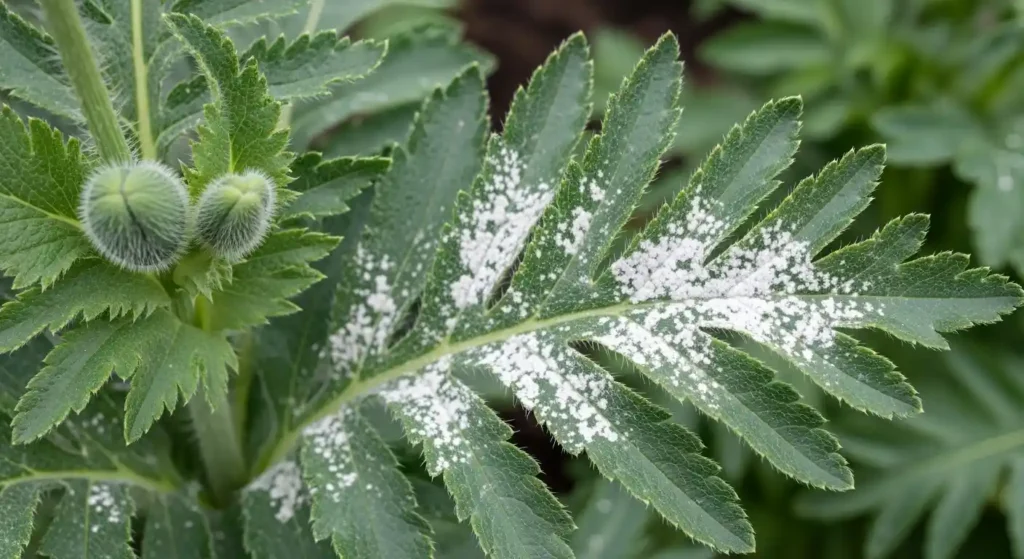
In This Article
If you’re looking for a showstopper perennial, oriental poppy is where it’s at. With its giant, crepe-paper-like blooms in vibrant red, orange, pink, and white, Papaver orientale brings serious drama to any garden. Native to the Caucasus region, the oriental poppy is surprisingly easy to grow once you understand its needs. Let’s face it, nothing beats those enormous oriental poppy flowers nodding in the breeze during late spring!
Plant Care Card
| Common Name | Oriental Poppy |
|---|---|
| Botanical Name | Papaver orientale |
| Family | Papaveraceae |
| Plant Type | Herbaceous perennial |
| Mature Size | 2-4 feet tall, 1-2 feet wide |
| Sun Exposure | Full sun to partial shade |
| Soil Type | Well-draining, moderately fertile |
| Soil pH | 6.5-7.0 (neutral) |
| Hardiness Zones | 3-7 |
| Native Area | Caucasus, Turkey, Iran |
| Toxicity | Toxic to humans and pets |
Oriental Poppy Care
These perennials are moderately easy to grow once established in the right conditions. The following sections cover everything from light and soil to common oriental poppy problems. Honestly, if you give these oriental poppies good drainage and sunshine, you’re already halfway there!
Light
Oriental poppies absolutely love full sun and need at least six hours of direct sunlight daily for the best blooms. In cooler climates, your oriental poppy will thrive in all-day sun, but gardeners in hotter regions should provide afternoon shade to prevent foliage scorching.
Too little light results in weak stems and fewer oriental poppy flowers. Place them in south-facing or west-facing garden beds where they’ll get morning sun. East-facing locations work too, though you might see slightly fewer blooms. According to Colorado State University Extension, many perennials require abundant sunshine for optimal blooming performance.
Soil
The secret to happy oriental poppies is excellent drainage, as these plants are prone to root rot in soggy conditions. They prefer moderately fertile, loamy soil that drains quickly after rainfall. According to Penn State Extension, well-draining soil prevents root rot in garden plants.
For heavy clay soils, work in compost, sand, or perlite to improve drainage. A DIY mix of 2:1:1 garden soil, compost, and perlite works wonderfully. Sandy soils benefit from added organic matter without staying waterlogged.
Water
Water oriental poppies deeply but infrequently, allowing the top 2-3 inches of soil to dry between waterings. During spring growth, water your oriental poppy once or twice weekly depending on rainfall. Similar watering needs apply to red geraniums, another sun-loving garden favorite.
Overwatering shows up as yellowing leaves and mushy stems. After blooming finishes, oriental poppies go dormant and need minimal water cut back to once every two weeks. Resume regular watering when new foliage emerges in fall.
Temperature and Humidity
Oriental poppies thrive in temperatures between 60-75°F during their growing season. They require winter chill to bloom properly, making the oriental poppy perfect for northern gardens. These plants tolerate average humidity without issue and don’t need special consideration in typical garden conditions.
Protect oriental poppies from strong winds, which can snap stems. Avoid planting near heat-radiating surfaces in hot climates, as excessive heat can shorten the blooming period.
Fertilizer
Feed oriental poppies with balanced liquid fertilizer like 10-10-10 once in early spring when new growth appears. A second light feeding after blooming helps the plant store energy. According to Michigan State University Extension, perennials generally don’t need heavy fertilization and excess can cause flopping stems. Stop fertilizing by midsummer when plants go dormant.
Propagating Oriental Poppy
The best time to propagate oriental poppies is during late summer or early fall when plants are dormant.
Propagating by Division

Division is the easiest method for multiplying oriental poppies, and it also helps rejuvenate older clumps.
Materials needed:
- Sharp spade or garden fork
- Clean, sharp knife
- Compost or potting mix
- Watering can
Steps:
- Wait until oriental poppy foliage has died back in late summer, then dig up the entire clump carefully, working around the root zone to avoid damage.
- Shake off excess soil and use your hands or knife to separate the oriental poppy clump into sections, making sure each division has several roots and at least one growing point.
- Replant oriental poppy divisions immediately at the same depth they were growing before, spacing them 12-18 inches apart in prepared soil enriched with compost.
- Water thoroughly after planting and keep the soil lightly moist until new growth appears in fall, then reduce watering through winter.
New plants will establish quickly and may produce blooms the following spring.
Propagating by Root Cuttings
This method works great if you want to create many new oriental poppies from one parent. Just like with French lavender, which propagates well from cuttings, these plants respond beautifully to this technique.
Materials needed:
- Clean, sharp knife
- Seed starting mix
- Small pots or trays
- Plastic bag
Steps:
- In late fall or winter, dig up an oriental poppy and cut 3-4 inch sections of thick roots, making a straight cut at the top and an angled cut at the bottom.
- Insert cuttings into pots filled with moist seed starting mix, positioning them vertically with the straight-cut end up.
- Cover pots with a plastic bag to maintain humidity and place in a cool location where temperatures stay around 40-50°F.
- Keep the soil barely moist through winter, and in spring, new shoots will emerge from the root cuttings.
Potting and Repotting Oriental Poppy
Oriental poppies have deep taproots and don’t do well in containers long-term. Choose containers at least 18 inches deep with excellent drainage holes. Use well-draining potting mix amended with perlite or sand.
Repotting is rarely necessary since oriental poppies prefer to stay undisturbed. If you must move a mature oriental poppy, do so in late summer when dormant. Young plants transplant more successfully than older specimens.
Common Pests and Diseases
Like most garden perennials, oriental poppies can occasionally attract pests. Penn State Extension IPM recommends integrated pest management strategies for effective control while minimizing environmental impact.
Spider Mites
Look for fine webbing on leaf undersides and tiny yellow speckling on foliage during hot, dry weather. Treat with insecticidal soap or neem oil spray, coating both sides of leaves thoroughly.
Aphids
These tiny insects cluster on new growth and flower buds, causing distorted leaves and sticky honeydew. Spray affected plants with insecticidal soap or introduce beneficial insects like ladybugs.
Downy Mildew

Fuzzy gray growth appears on leaf undersides with yellow patches on top in humid conditions. Remove affected foliage immediately and improve spacing between oriental poppies for better airflow.
Root Rot
Mushy, blackened roots and sudden wilting indicates fungal root rot from overwatering. Prevention through proper drainage and careful watering is key for oriental poppies.
Common Problems with Oriental Poppy
Here’s how to troubleshoot common oriental poppy issues:
Yellow Leaves
Yellow leaves can mean several things. During active growth, yellowing signals overwatering—check if soil stays soggy and improve drainage. Yellowing in midsummer is normal as oriental poppies enter dormancy.
Nutrient deficiency causes pale yellow leaves with green veins, which responds to fertilizer in early spring. Just like with red chrysanthemums, yellowing can indicate various issues, so observe the overall plant health first.
Brown Leaves
Brown leaf edges develop from inconsistent watering during hot spells. Water deeply and regularly during spring growth. University of Maryland Extension recommends allowing soil to dry moderately between waterings for perennial health. Underwatering causes entire leaves to turn brown and crispy, starting from the edges inward.
Drooping or Wilting Leaves
Drooping during the hottest part of the day is normal and plants perk up by evening. Persistent wilting indicates problems. Overwatering causes soft, mushy wilting, while underwatered plants wilt dramatically but recover quickly once watered.
Similar drooping issues occur with firefly petunias when watering isn’t consistent, so check soil moisture first.
No Blooms or Poor Flowering
Insufficient sunlight is the primary cause of reduced blooming. Make sure plants get at least six hours of direct sun. Young oriental poppies may skip flowering for a year while establishing roots. Excessive nitrogen fertilizer promotes leafy growth at the expense of flowers.
Plants Disappear After Blooming
This is completely normal! These perennials go dormant after flowering in early summer and foliage dies back completely. New foliage emerges again in autumn and persists through winter in milder climates. Plant oriental poppies with later-blooming perennials that will fill the space.
FAQ
Do oriental poppies come back every year?
Yes, oriental poppies are hardy perennials that return year after year. They go dormant in summer after blooming but new foliage emerges in fall and persists through winter in mild climates.
Do oriental poppies like sun or shade?
Oriental poppies prefer full sun with at least six hours of direct sunlight daily for best blooming. In extremely hot climates, afternoon shade helps prevent foliage scorch during peak summer heat.
Are oriental poppies invasive?
No, oriental poppies aren’t invasive. They have deep taproots that keep them in place rather than spreading aggressively. However, they self-seed readily, so deadhead spent flowers if you don’t want volunteers.
Is oriental poppy toxic?
Yes, all parts of oriental poppies are toxic to humans and pets if ingested. They contain alkaloids causing nausea, vomiting, and drowsiness. Keep them away from curious children and animals.
